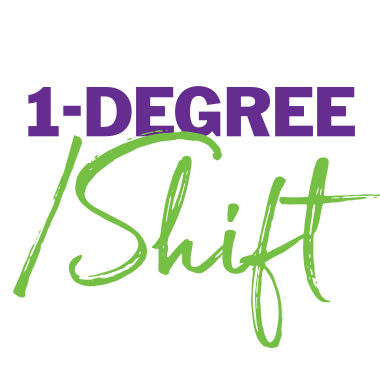We become what we repeatedly do.
―
Over the past few years, our team at 1-DEGREE/Shift have been leading workshops that help empower individuals to better manage their well-being. This blog shares the valuable insights we’ve learned in our journey, providing a transformative guide to taking personal ownership of your well-being and cultivating better habits.
One thing we know about life is that it is dynamic and not always predictable. At times you’ll feel on top of the world, at peace and in ‘the zone’. Other times it will throw you tough curveballs – it can get messy and it’ll feel at times like everything is out of control. With all these ups and downs it can feel a bit like being thrown by the waves of life – ungrounded. When things are good, we are good – when things are bad, we are bad. Struggle is real, and it is a perfectly normal part of life – but how can we better navigate these inevitable ebbs and flows and take care of ourselves no matter what life throws at us?
“You can’t stop the waves, but you can learn how to surf” – Jon Kabat-Zinn
The answer requires some self-reflection and getting to know yourself. It all starts with noticing what fuels, energizes and restores you – discerning what helps nurture your mental and physical well-being. Which activities bring you a sense of calm or relaxation? What hobbies fill you with joy? How do you typically reset when the need arises? These are the positive triggers that will help ground us no matter what level of struggle we are feeling. After we know what those things are, the next step is bridging the gap between thought and action and building those things into your daily routines. We are creatures of habit, so knowing how to successfully form habits that strengthen our resilience will help sustain us through the uncharted territory of the year ahead.
Identifying Positive Triggers for Well-being
Identifying positive triggers for your well-being is like uncovering the secret sauce that powers your vitality. The ingredients will be unique – only you know what works best for you. These triggers, subtle yet mighty stimuli, possess the ability to ignite your spirit and rejuvenate your essence. From introspective reflections to playful activities to mindful observation of your routines, you learn what invigorates and restores you —be it the rush of endorphins from a brisk run, the warmth of connections forged while socializing, or the soul-nourishing joy found in a gratitude practice. Here are some practices you can tap into to cultivate this awareness:
- Mindful Presence: Start by being present in your daily activities. Notice how different actions, environments, or interactions make you feel. Engage in activities deliberately, paying attention to your emotional and physical responses. Ask yourself, “Where am I?” – this will help you with identifying whether you are present or not.
- Reflective Journaling: Keep a journal to jot down your experiences. Record moments that uplift or drain your energy. Reflect on activities that bring joy, fulfillment, or a sense of accomplishment.
- Experimentation: Try new things! Experiment with various activities—whether it’s exercising, engaging in creative pursuits, spending time in nature, or connecting with different people. Observe how each experience impacts your mood, energy levels, and overall well-being.
By combining these approaches, you’ll gradually develop a deeper understanding of the activities, interactions, and environments that nurture your individual well-being. It’s an ongoing process of exploring what your positive triggers are, so remember to be patient with yourself!
Bridging the Gap: Simplifying the Choice from Thought to Action
Many of us already know what things are good for our well-being – the challenge is closing the gap between thought and action. It’s that puzzling disconnect between understanding what’s beneficial for our well-being and consistently making those choices. All kinds of complexities are at play here: the tug-of-war between competing priorities, the allure of instant gratification over long-term benefits, and the subtle interplay of emotions and habits. Ingrained beliefs, subconscious patterns, and external cues shape our actions, revealing why prioritizing well-being habits remains challenging despite good intentions. So how do we make consistently choosing healthier habits easier?
“Make it so easy you can’t say no.” —Leo Babauta
1. Start Small
The first way we make it easier is by starting with tiny habits to make the new habit as easy as it can be in the beginning. If your goal is an exercise habit, start small – maybe it’s a daily short walk, or choosing the stairs over the elevator when you can. Instead of trying to meditate for 10 minutes a day, maybe you start with some simple breathing exercises for one minute a day. From there you can gradually increase that habit in small ways.
2. Get Clear Using the New Habit Formula
The pivot lies in habitualizing practices that fortify our daily routines. Enter the New Habit Formula— created by Michael Bungay Stanier, it’s a simple yet transformative method for replacing old habits in our lives with new ones. The components are: the trigger (X), the current habit (Y) and the new habit you want to make (Z).

Let’s use the example of wanting to incorporate exercise at the end of the day. There may be one or a few barriers before we actually get to work out. One of the first barriers for me personally is getting into the workout clothes – it makes it a lot harder to decide not to workout if I’m already in the gear. So if you’re like me, setting yourself up for success might look like starting small and forming a habit around putting on the workout clothes, which will lead to a higher likeliness of actually exercising. My formula might look like this: when I get home from work (X), instead of watching TV (Y) I will promptly change into work out clothes (Z).

This will make the decision to work out easier as you’ll already be prepped and ready to go. This synchronization taps into the power of an existing routine (arriving home) to effortlessly cue the new behaviour (preparing for exercise).
“Habits are like the atoms of our lives, each one is a fundamental unit that contributes to your overall improvement.”– James Clear
3. Habit Stacking
Leveraging already existing habits to change behaviour is called habit stacking. It’s an ingenious technique merging multiple habits into a single ritual. By stacking habits, such as pairing a daily walk immediately after breakfast, we create a chain reaction of positive behaviours. The breakfast routine serves as a trigger for the walk, fostering an interconnected flow of well-being practices. The best part? Very little mental energy is required since the new habit is triggered by something you already do daily.
“The first mistake is never the one that ruins you. It is the spiral of repeated mistakes that follows. Missing once is an accident. Missing twice is the start of a new habit.” – James Clear
4. Be Consistent, Be Compassionate
When we are building a new habit, the key is to be as consistent as possible. In the beginning, this is not going to mean hitting it every single time. There will be instances where we drop the ball – that’s natural. What’s more important is to pick it back up again-and in this process making sure we stay kind to ourselves. Our inner-critic can be ruthless. Remember that we get energized through support and nurturing. It will be easier to get back on track when we are encouraging of ourselves instead of tearing ourselves down.
Conclusion
Solidifying habits requires reinforcement and support. Tracking progress, celebrating small victories, forging accountability partnerships, and cultivating mindfulness and self-compassion all fortify the habit-building journey. Be prepared to be flexible, too—adjusting habits to evolving circumstances ensures their sustainability amidst life’s flux.
Remember this: the magic lies in turning insights into action. It’s time to take those small, intentional steps toward a healthier life. Consistent habits aren’t just a promise; they’re an open door to a life filled with energy and possibilities. As James Clear, author of Atomic Habits, says “making a choice that is 1% better or 1% worse is insignificant in the moment. But over the span of moments that make up a lifetime, these choices determine the difference between who you are and who you could be”. By cultivating habits that align with our deepest aspirations, we seize the reins of our destiny and help move ourselves toward the person and life we truly desire.
Mali Foster


